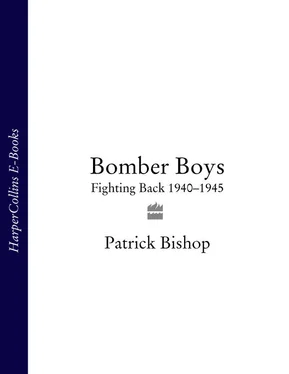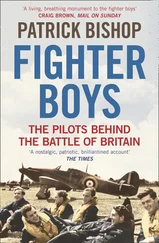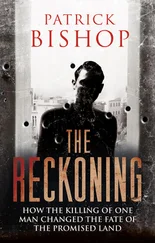At some OTUs new arrivals were given up to a fortnight to team up. Harry Yates, having got over his disappointment at not being posted to a fighter squadron, arrived at Westcott with the ambition to ‘skipper a well-drilled crew, the best on the squadron, every man handpicked, utterly professional at his job and dedicated to the team.’ He started his search in the officers’ mess where he found himself at the bar next to Pilot Officer Bill Birnie, a stocky New Zealander navigator who ‘seemed to be the sort of tough-minded chap who knew the score’. During the evening’s socializing he noticed a young pilot officer wearing a wireless operator’s badge. For a wireless operator to be commissioned so early in his career suggested exceptional ability. So Rob Bailey, ‘tall, slim and blessed with the dark, aquiline looks that women tend to admire’, was in.
The following day the 220 men of the intake assembled in a hangar to finish off the process. They were mostly formed into twos and threes now and there was ‘a lot of movement and noise’, as they scrambled to complete their teams. Bill Birnie disappeared into the crowd and returned ‘with a bronze-skinned giant in tow. This was Flight Sergeant Inia Maaka, the first Maori I’d ever met and I knew the bomb-aimer for me.’ Mac, as he immediately became known, ‘was a stranger to the inner tensions and vanities that make liars of the rest of us’. He had wanted to fight the war as a pilot and had won a place at elementary flying school but had not been selected to advance and been reassigned to bombing school. ‘He clearly loved the job,’ Yates recorded, ‘there wasn’t a hint of second best.’ It was Mac who found the gunners: Geoff Fallowfield, an extrovert eighteen-year-old Londoner and Norrie Close, a taciturn Yorkshireman, who was a month younger still. ‘So there they were,’ Yates marvelled later, ‘my crew: a straight and level Kiwi, a ladykiller; a Maori warrior; and two lads as different as chalk from cheese.’ 19
Such assorted crews were the norm. The mysterious chemistry that had brought them together was durable. Many crews forged bonds of affection and respect that, if they came through the war, lasted until the grave. It was rare for an Englishman to have met a Canadian or an Australian, yet when crewing up they seemed drawn to each other, confirming the wisdom of the process. Group Captain Hamish Mahaddie, who was tasked with finding talent for the Pathfinder Force, which was formed to lead the main bomber force to the target, believed that ‘the best crews were a mixture’. 20
The system was not perfect. At Bruntingthorpe OTU Cyril March teamed up with an Australian skipper, navigator and wireless operator. The rest of the crew were English. ‘We did our job and had one or two good thrashes but we were never all together and to my mind we didn’t gel.’ Their first training trip was a fighter affiliation exercise in which the pilot was expected to throw the Wellington around the sky to shake off the ‘attacker’. After a row with the navigator, he appeared to lose control and ordered the crew to crash positions. The bomber landed but overshot the runway coming to a halt in the grass. The next trip took place in clear sunshine but the captain still managed to lose his way. March ‘felt so bloody helpless. I was doing my job, telling them when we were passing over airfields and such. I couldn’t help thinking [what] if this were Germany on a black night with duff winds etcetera – Christ!’ Word of the crew’s failings reached the station authorities. It was split up and its members redistributed. This time March was lucky. The first of his new comrades was Ken Ford, a Londoner, who with the rest of the crew, became his lifelong friends.
Ken took me to meet my new skipper, a tousle-haired fair Aussie with steady blue eyes and a friendly grin. ‘I’m Neville Emery,’ he said, ‘Bug to my mates.’ I had noticed he had been eyeing me up and down and asked him why. ‘Oh nothing mate,’ he said laughing. ‘Kenny was telling me that you were an old married man.’ I was just twenty-one. I met Des Gee the Aussie wireless operator, again blond and blue-eyed; then Ray Brooker, a dark Englishman from Cambridge, the bomb-aimer with a ready smile. Then I met Terry Sayles, a Yorkshireman from Doncaster, the navigator. I told him my name was Cyril. ‘Hi Cy,’ he said and that was my name thenceforth. Des got me a bed in their Nissen hut and helped me move my gear in. That night they weren’t flying and they said, ‘Coming down the village for a jar?’ ‘Sure,’ I said.
‘Where’s your bike, Cy?’ Terry asked. ‘Bike!’ I replied, ‘I haven’t got one.’ He got one, I don’t know where and I didn’t ask. Off we went in formation. I knew I was in a crew at long last.
They came back in high spirits, yelling ‘Bring out your dead’ as they wobbled on their bikes over rickety planks bridging the Leicestershire ditches. Cyril was happy and content. ‘I knew then that with these lads we would survive, no doubt about it.’
This, in the end, was what the airmen were searching for as they milled around the hangars looking for kindred spirits. An efficient air, a friendly manner were all very well. But in the end, the most attractive quality anyone could possess was to seem lucky.
Inevitably, when the mating ritual finished, a gaggle of wallflowers remained. ‘At the end of the day there were some odd bods left around who … had no choice but to take the leftovers,’ said Tom Wingham, who flew with 102 Squadron. ‘[You] had a feeling that they weren’t going to make it and inevitably they didn’t. They didn’t have that same sort of “gel”. I suppose you could say they had the smell of death about them and it was not funny.’ 21
The men that would lead them through the final stage of training and into the daunting world of ‘ops’ seemed old, even though many were only in their mid-twenties. These were the veterans, ‘tour-expired’ survivors of thirty operations or more. ‘It was our first close contact with people who had completed operations, surviving against unlikely odds,’ wrote Dennis Field. ‘Gongs were common, almost part of the dress, and worn without flamboyance. Although we were keen to hear and learn all we could, in off-duty hours they stayed detached and there was little line-shooting in our presence. We realized that within a few months we should all meet some ultimate experience.’
Instructing posts were the reward for survival. Not that such jobs were free of risk. Half of the flying done at OTUs was at night. The darkness, and the sometimes clapped-out machines which were used for training meant that deadly accidents were routine. After agreeing to fly with one captain, Dennis Steiner was approached by two other pilots whom he had to turn down. Subsequently, one flew into the ground for no discoverable reason, killing himself and all his crew. The other developed engine trouble during a flight and ordered the crew to bale out. ‘Their luck ran out soon after when at night a practice bomb from another aircraft fell on them and they crashed,’ he wrote. ‘None of the crew survived. The line between surviving or not was becoming very thin.’
It seemed to Ken Newman that at least some of the accidents were due to criminal recklessness rather than the demands of war. In February 1944 he went to a Heavy Conversion Unit for a month’s training. This was where crews familiarized themselves with the types that they would be flying on operations. Newman was learning his way around the Halifax. ‘The aircraft were old, poorly maintained and in the most part barely airworthy. But it was constantly drilled into us that complaints would not be entertained and if we refused to fly because we thought a Halifax was not airworthy, or for a reason that the staff decided was trivial, we would be treated as LMF [Lacking in Moral Fibre, the RAF bureaucratic euphemism for the accusation of cowardice].’ This was very much the view of the chief flying instructor who Newman held responsible for the death of one of his best friends and all his crew.
Читать дальше












